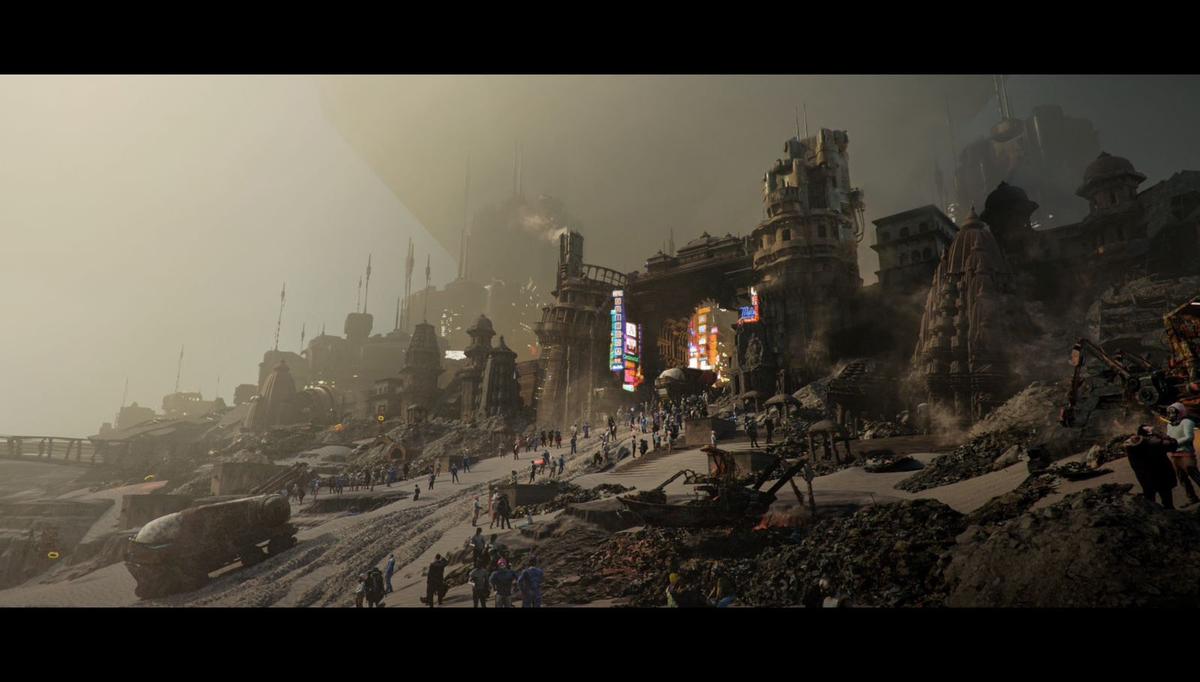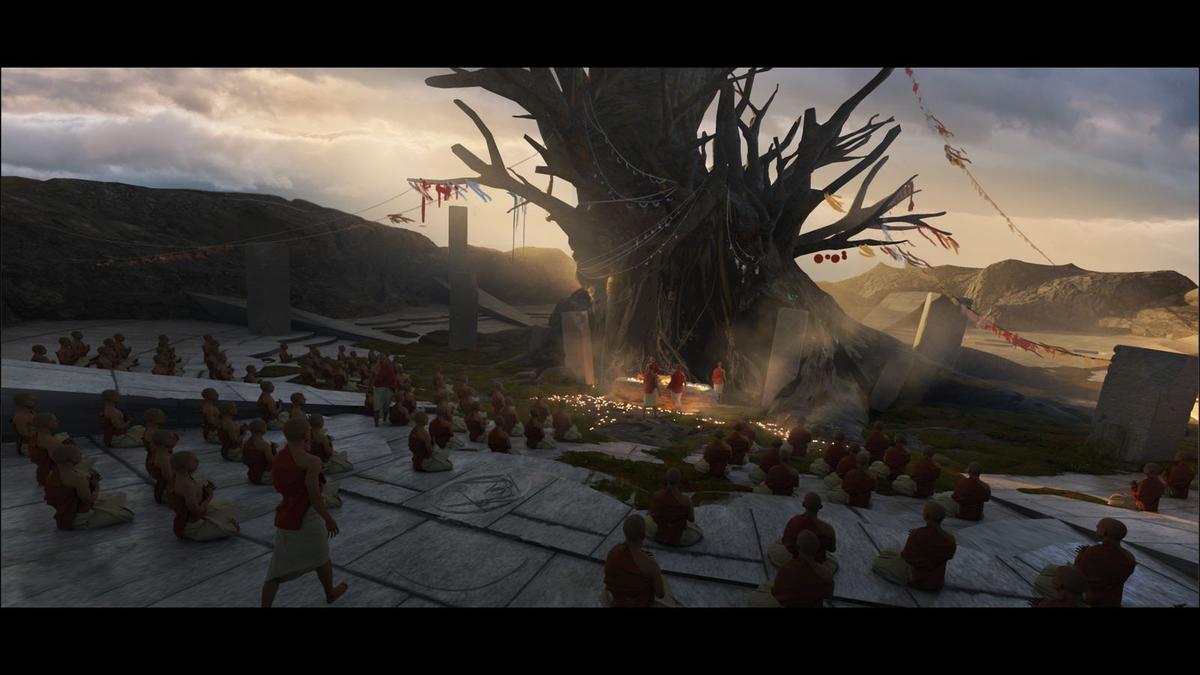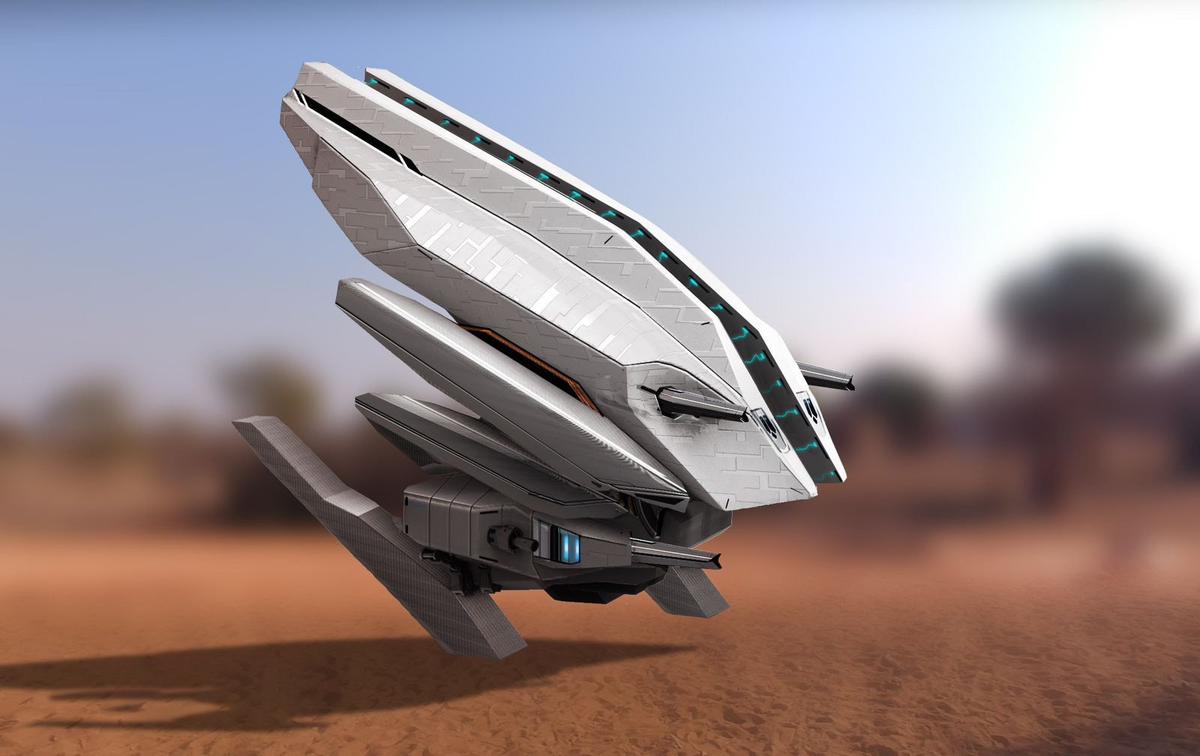Table of Contents
Towards the end of 2019, Nitin Zihani Choudhary met director Nag Ashwin. By then, his production design for Tumbbad (2018) had fetched him recognition and accolades. An alumnus of the College of Art, New Delhi, Nitin had worked on Tumbbad for six years. On learning this, Nag Ashwin remarked jovially that he would likely be tied up with Kalki 2898 AD for the next four years. “I was the first to be on board (in the technical team) since it would take time to develop the designs,” says Nitin in an interview with The Hindu.
Nitin was intrigued by the storyline that brought together the Kurukshetra war and futuristic, dystopian science fiction. “I knew it would offer me a big space to play with the design,” he says about the film starring Amitabh Bachchan, Prabhas, Deepika Padukone, and Kamal Haasan, that has garnered more than ₹900 crore worldwide.
A BFA (bachelor of fine arts) graduate with a keen interest in painting, illustrations, and sculpture, Nitin also learnt 2D and 3D animation. “My parents were concerned that I was not focusing on one aspect of art.” When he did storyboards for advertisements and then entered cinema, all his skills could be put to use. In Kalki 2898 AD, he also brainstormed with the 3D and visual effects teams.
Nitin designed posters for director Anand Gandhi’s Ship of Theseus, paving the way for Tumbbad. Atrangi Re followed. “Atrangi Re gave me a taste of mainstream Hindi cinema and was a lovely experience.”

When Nitin began working on Kalki, the screenplay was still evolving. The design language evolved as Nitin’s team along with concept artists and art directors worked on the city of Kasi, Complex, Shambala and Kurukshetra.
At the time, Nitin had asked Nag Ashwin why he wanted to make an unusual film for which there was no precedence. “He had been working on the idea for a while and had his reasons.” At one point, Nitin wondered if the entire story would fit into a single film. “Somewhere down the line, it evolved into two parts, given the number of characters and their arcs. Take Bhairava, for example. He starts as a selfish guy who wants to go to the Complex and by the end of the first film, his character arc is still developing. He is not yet the perfect man.”
Kasi as a ravaged vertical city

The exteriors and entrance to Kasi in the film
| Photo Credit:
Special Arrangement
In the film, Kasi is portrayed as a dilapidated city. The mighty Ganges has dried up, and people are in despair; there is scarcity of food and water. “We planned a mini city,” says Nitin. “We built a huge set (at Shankarpally, Hyderabad) with the main street, alleys, a grand entrance, interiors, and other elements. For some portions, we ensured that the sets were at least 400×400 metres so that there would be enough depth to capture on camera. The height went up to 30 feet.”
Bhairava’s (Prabhas) introduction action sequence was filmed on bridges of varied heights. Ruined portions of temples are also part of the design, aligning with the script. “It was exciting to bring in elements of science fiction into a dystopian Kasi.”
Nitin’s team designed a 400-page lookbook, detailing the different worlds of Kalki. However, he soon felt something amiss. “The designs looked good on their own, but I felt they may not gel well together to be part of one city or a timeline. We went back to the drawing board,” he says, and adds, “When I say ‘we’, I refer to the entire team, including producer Priyanka Dutt; she was hands-on with the workflow. Priyanka worked closely with the art and production teams, while Swapna (Dutt) worked with the costume department.”
The art department
Art directors Anil Jadhav, Santosh Shetty, Velu and Rembon have been part of the art team. Nitin also mentions Prakeerthi Uppalapati and others from the production and direction department who ensured a smooth workflow.
Nitin explains that Kasi was imagined as a vertical city in which “the demigods (such as Ashwatthama) were underground and the rakshasas (Yaskin and his army) ruled from above. Since people in Kasi are deprived of food and water, they look upwards to the Complex.” He draws an analogy and says the huge construction that leads to the inverted pyramid can be compared to common people trying to touch the feet of the Complex.

For Kasi, the colour palette is a mix of yellows, browns, and blacks in contrast to the blue (water) and green (vegetation) that define life at the Complex. Commander Manas, raiders and others who control Kasi from the Complex, wear costumes (designed by Archana Rao) in black and gold, to highlight their dominating nature.
The song featuring Bhairava and Roxie (Disha Patani) in the Complex features a replica of the iconic David statue of Michelangelo. The design involved a few trials, and Nitin’s multidisciplinary skills came into use.
Yaskin, an antithesis of God
“We imagined Yaskin as a fallen God or as an antithesis of God,” says Nitin, affirming that the circular space he inhabits is a metaphor to the womb, surrounded by water. “For women in the lab, we designed spaces that resemble cages in a large prison.”
The stairs that lead to Yaskin’s chamber have murals tracing the evolution of mankind. On the other side of Yaskin, on the walls, are circular spaces with imagery of humans in a foetal position. “Yaskin is at the centre, fashioning himself like God, as though at the cusp of another stage of evolution.”
Shambala and the mountains

The tree at the heart of Shambala
| Photo Credit:
Special Arrangement
Shambala, as a hidden land in the mountains, is largely in hues of white. “Shambala is hidden within the snow-capped ranges, and it made sense that all their constructions, weapons, homes and clothes would be in shades of white, off white and grey based on the material available to them. It also helps as camouflage.”
The large central tree (alluding to tree of life), was a 30-foot structure designed by the art and production team and was later extended using visual effects.
In the early stages of design, a temple was featured at the base of the tree. It was removed later, since Shambala is portrayed as a refuge for people from different religions and cultures. “We removed religious references and went with the idea of the tree as the mother God,” says Nitin.

Detailing in Kurukshetra
In the Kurukshetra portions, Nitin draws attention to the minute details that went into designing the flags used on the chariots of warriors, and the elephants. “We could not take shortcuts and use printed flags, for example. Each flag you see on a warrior’s chariot has threadwork, and at times, is embedded with fake gemstones. Finally, when we watched it on the monitor, we noticed that the flags were somewhere in the background. Even then, Priyanka did not question when we needed to design something appropriate to the period.” One of the design elements included constructing a 17-foot elephant, which, when enhanced by visual effects, would appear realistic.
For the Kurukshetra portions, the art, production and costume departments worked towards depicting the war imagery as raw, dry and Indian and chose brown and blood-soaked hues so as to not make it appear like Game of Thrones.
Automobiles and artillery

Concept art of the monobike
| Photo Credit:
Special Arrangement
Prior to the release of the film, all eyes were on the custom-built vehicle Bujji, designed first in-house and executed with the help of Anand Mahindra’s team and Coimbatore-based Jeyam Motors. Nitin discloses that approximately 20 to 24 vehicles were designed for the film, of which we have only seen a few in the first part. “All the vehicles were designed to ply on the roads, with wheels, and VFX was used to show some of them flying. The structure is all real,” says Nitin.
The film has weapons that purportedly belong to the Kurukshetra period, such as the Gandiva and Vijaya Dhanush bows, spears, and arrows, as well as futuristic guns for the sci-fi portions. “In this age of AI (artificial intelligence), no design is left unexplored. We had to work on bringing something new and innovative,” says Nitin.
For the futuristic guns of 2898 AD, they began by wanting to design unconventional guns without triggers and barrels. “It was like reinventing the wheel.” A starting point was trying to design guns shaped like knuckle dusters with buttons and keys for every move. “Some of these guns also open up into a sphere-shaped larger weapons. We had detailed science charts on how these guns would work.”
For some of the Shambala guns, Nitin used principles of Cubism (introduced by artists Pablo Picasso and Georges Braque) to depict 3D reality through geometrical shapes on a 2D canvas. “It was a tough design to develop and white is an unusual colour for a weapon.”

Nitin jokingly states that he could explain the design language of each world of Kalki for hours and that they spent 80% of the time conceptualising and designing on paper and 20% of the time executing it. He recalls being amused when a temple structure they built for the film, with the Shiva linga, was mistaken to be a real temple by Nag Ashwin’s and Priyanka Dutt’s mothers. “They would remove their footwear before entering the place, and also conduct pujas. After that, all of us considered the space to be a temple.”
Given the huge volume of work that has gone into making the film, did the team consider documenting it? “We did think of a coffee table work, and I think it is in progress,” says Nitin.

